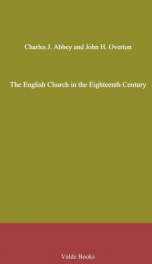The English Church in the Eighteenth Century

Purchase of this book includes free trial access to www.million-books.com where you can read more than a million books for free. This is an OCR edition with typos. Excerpt from book: INTRODUCTORY 13 would now be understood by tolerance, it was fully up to the level of the times. It fairly expressed what was thoroughly the case; that the spirit of intolerance had very much decreased, and that a feeling in favour of religious liberty was decidedly gaining ground Meanwhile, in King William's reign, and still more so in that of his successor, there was a very strongly marked contention and perplexity of feeling as to what was really meant by toleration, and where its limits were to be fixed. Everybody professed to be in favour of it, so long as it was interpreted according to his own rule. The principle was granted, but there were few who had any clear idea as to the grounds upon which they granted it, and still fewer who did not think it was a principle to be carefully fenced round with limitations. The Act of Toleration had been itself based in great measure upon mere temporary considerations, there being a very strong wish to consolidate the Protestant interest against Papal aggression. Its benefits were strictly confined to the orthodox Protestant dissenters ; and even they were left under many oppressive disabilities. A great principle had been conceded, and a great injustice materially abated. Henceforth English Dissenters, whose teachers had duly attested their allegiance, and duly subscribed to the thirty-six doctrinal articles of the Church of England, might attend their certified place of worship without molestation from vexatious penal laws. It was bare toleration, accorded to certain favoured bodies ; and there for a long time it ended. Two wide- reaching limitations of the principle of tolerance intervened to close the gate against other Nonconformists than these. Open, heresy could not be permitted, nor any worship that was adjudged to be distinct... --This text refers to an alternate Paperback edition.
Info about the book
Author:
Series:
Unknown
ISBN:
1177834758
Rating:
3/5 (4)Your rating:
0/5
Languge:
English
Users who have this book
Users who want this book
What readers are saying
What do you think? Write your own comment on this book!
write a commentGenre
if you like The English Church in the Eighteenth Century try:
Other books by this author
Do you want to exchange books? It’s EASY!
Get registered and find other users who want to give their favourite books to good hands!


